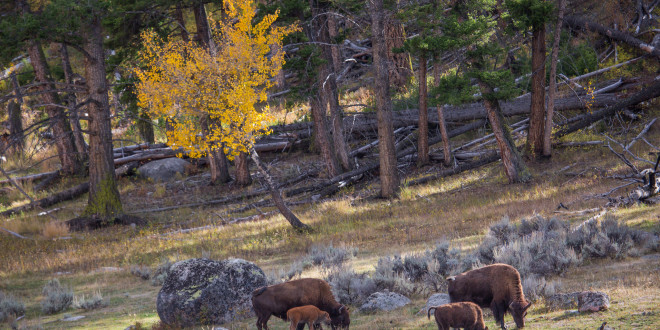Officials want to curtail Yellowstone bison management in western parts of Montana and cap this year’s cull at 1,250 bison at the most.
Biologists Chris Geremia, Rick Wallen anad P.J. White made these recommendations in the annual “Status Report on the Yellowstone Bison Population,” mandated under the Interagency Bison Management Plan.
Last week, we reported the bison population in Yellowstone National Park measured around 4,800 head, down from the estimated 5,500 bison present in Yellowstone around this time in 2016. The report, which you can read here, puts the count at 4,816. The count was conducted via aerial survey.
Yesterday, biologist Wallen did a Facebook Live presentation on the report and answered questions about the report’s conclusions and the Yellowstone bison herd as a whole. You can watch that below.
According to the report, 3,969 bison were observed in northern Yellowstone with 847 in central Yellowstone. The central herd numbers were striking, showing a 42-48% decline from the central herd count in 2016. Indeed, the report notes more and more bison are migrating to northern Yellowstone, where they are more likely to be captured for slaughter or hunted. From the report:
We estimated about 27% of the population was composed of per-reproductive animals, which included calves and males and females between 12 and 16 months of age. Seventy-three percent of the population was composed of adults at least 2 years of age. Over the past five years, the age composition has averaged 31% juveniles and 69% adults, which met our objective of averaging 30% juveniles and 70% adults. It is likely the juvenile proportion of the population has been reduced below maximum values that approached 34% during 2013-2016. The current population consists of approximately 44 calves per 100 adult females, which is reduced from a high of 51 calves per 100 adult females measured during 2013 and 2016, but near the long-term average of 43 calves per 100 adult females. The ratio of per-reproductive animals per 100 adults was similarly reduced from a high of 92 in 2013 to 78 in 2017, which is near the long-term average of 75 per 100 adult females.
The report recommends culling at least 600 bison during winter 2017-18 to stabilize the population. Removing 1,000 bison would “likely decrease bison numbers to about 4,400 after calving next summer.”
As mentioned, officials don’t recommend killing more than 1,250 bison, or 25% of the current population.
This past winter, over 1,200 bison were removed from the herd, one of the largest culls in years. Nearly 500 were taken by hunters while 748 were shipped to slaughter facilities. The report notes two bison died in captivity while three were shot while leaving a Montana conservation area.
35 bison are being kept in Stephens Creek, where Yellowstone officials hope to create a quarantine area to clear bison of brucellosis, which could allow bison to roam further outside the Greater Yellowstone Area or even let them be shipped to other herds around the country.
Besides the cull cap, Wallen et al. are recommending managers focus on the northern herd while maintaining 200-450 animals north of Mammoth Hot Springs within conservation areas for the purpose of state and tribal hunting. They also recommend leaving bison alone in the western management area of Montana; according to the report, bison in that area “are almost entirely from the central breeding herd, which has decreased substantially in abundance during recent years.”
 Yellowstone Insider Your Complete Guide to America's First National Park
Yellowstone Insider Your Complete Guide to America's First National Park





